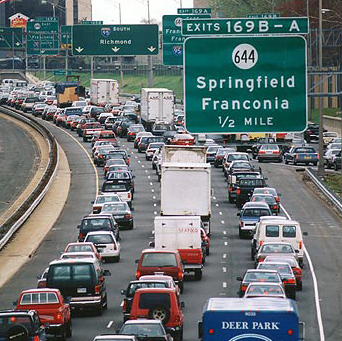Not only do you often find yourself with the desire to kill others when in heavy traffic, turns out waiting around in traffic could actually kill you. No joke. People who have had a heart attack are likely to report having been in traffic shortly before their symptoms began, researchers reported at the American Heart Association’s 49th Annual Conference on Cardiovascular Disease Epidemiology and Prevention.

In a German study of patients who had a heart attack, researchers found the patients to be more than three times as likely to have been in traffic within an hour of the onset of their heart attack. The researchers also observed small but statistically significant increases in the chance that a heart attack occurred within six hours after exposure to traffic.
Driving a car was the most common source of traffic exposure, but taking public transportation or riding a bicycle were other forms of exposure to traffic. Overall, time spent in any mode of transportation in traffic was associated with a 3.2 times higher risk than time spent away from this trigger. Females, elderly males, patients who were unemployed, and those with a history of angina were affected the most by traffic.
“Driving or riding in heavy traffic poses an additional risk of eliciting a heart attack in persons already at elevated risk,†said Annette Peters, Ph.D., lead author of the study and head of the research unit at the Institute of Epidemiology, Helmholtz Zentrum Muchen, Germany. “In this study, underlying vulnerable coronary artery disease increased the risk of having a heart attack after driving in traffic.â€
While this study wasn’t structured to pinpoint the reasons that being in traffic may have increased the risk of heart attack, “one potential factor could be the exhaust and air pollution coming from other cars,†Peters said. “But we can’t exclude the synergy between stress and air pollution that could tip the balance.â€
The researchers reviewed cases of heart attack through the KORA registry in Augsburg, Southern Germany between February 1999 and December 2003. They used a standardized interview with 1,454 patients to collect data on potential triggers of heart attack, including exposure to traffic in the four days prior to heart attack symptom onset.
The patients had a known date and time of heart attack and all had survived 24 hours after the heart attack. Participants were asked what they did the day of the heart attack, where they went, the means of transportation and time spent in traffic. The average age of the participants was 60 years and about 25 percent were women.
Previous studies by the researchers showed that those participating in strenuous activity such as playing soccer or squash or performing heavy work such as painting overhead or snow shoveling had five to six times the risk of heart attack in the subsequent hours after the activity.
This study showed that about 8 percent of the heart attacks in the group were attributable to traffic, Peters said. “It’s just one of the factors, but it’s not a negligible number.
“We were initially surprised to observe such a strong connection between traffic and heart attacks, which we first published in 2004 based on a case series of 691 patients. It is reassuring that we were able to reconfirm this association in an extended case series. Now it’s important to find out what is behind this, whether it is air pollution or stress or both.â€
The researchers also said they were surprised that women appeared to be in the higher-risk group. “Their risk is more than five times higher,†she said. “We’re not sure what the physiological mechanism is behind this; however, it might also be due to the smaller number of women as we only interviewed 325 women in five years. A larger sample of women might have provided enough statistical power to detect a more accurate assessment of risk.â€
The researchers are doing further studies to explain the reasons that exposure to traffic was associated with a higher risk of heart attack. They’re conducting a study on 120 healthy volunteers as part of the University of Rochester Particle Center, funded by the U.S. Environmental Protection Agency (EPA). The volunteers are fitted with Holter monitors providing electrocardiograms, and are monitored for exposure to air pollution and noise. After they are outfitted, they go to work or home or run errands and then return five hours later. The researchers are extending the study to those with diabetes or impaired glucose tolerance.
“Measures to improve air quality within metropolitan areas and reduction of emissions from vehicles are likely to reduce risk for heart attacks,†Peters said.
The U.S. EPA introduced its 1997 National Ambient Air Quality Standards (NAAQS) to educate the public about daily air quality levels, including information about ozone and particulate matter levels. These daily updates can be found on the EPA Web site here and in many newspapers across the country.
What sucks most about this is that traffic pollution effects people who are not driving (bikes/bus/walking). In most parts of the state I live in it is illegal to smoke in restaurants. Presumably because the cancer causing smoke would give non-smokers (who don’t want to smoke) cancer. How long will it be before we start to apply the same principle to emissions that both kill people, and destroy the planet…